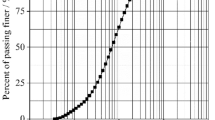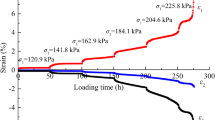Abstract
The theory of isotach elastoplasticity (IEP) is applied to investigate the strain rate and time effects in Osaka Bay clay from Japan. The IEP theory considers geomaterials like clays as an overdamped oscillatory physical system, for which the strain rate (analogous to the vibration frequency) decays in an exponential manner. This feature can be captured by a characteristic strain rate and time relationship. The evolutionary change of strain rate is found to affect the mechanical response of soft clays in an isotach manner. A loading–isotach (LI) yield curve is proposed in the stress and strain rate plane. Combination of the characteristic strain rate and time relationship in an isotach manner into the framework of critical state soil mechanics renders an isotach (rate-dependent) elastoplastic (IEP) constitutive model. A total of 9 model parameters is required, and their values can be properly determined via conventional laboratory tests. The validity of the proposed IEP is demonstrated using experimental data for Osaka Bay clay under various stress paths and strain rates, namely, long-term creep, constant rate of strain loading, relaxation, and their combination. Comparison of the model predictions and experimental results demonstrates that the theory of isotach elastoplasticity can be successfully applied to capture the strain rate and time effects on the mechanical behaviour of Osaka Bay clay.










Similar content being viewed by others
References
Adachi T, Oka F (1982) Constitutive equations for normally consolidated clay based on elasto-viscoplasticity. Soils Found 22(4):57–70
Bjerrum L (1967) Engineering geology of Norwegian normally-consolidated marine clays as related to settlements of buildings. Géotechnique 17(2):83–118
Dafalias YF (1986) An anisotropic critical state soil plasticity model. Mech Res Commun 13(6):341–347
Feda J (1989) Interpretation of creep of soils by rate process theory. Géotechnique 39:667–677
Gens A (1982) Stress–strain and strength of a low plasticity clay. Ph.D., University of London, UK
Hashiguchi K, Okayasu T, Saitoh K (2005) Rate-dependent inelastic constitutive equation: the extension of elastoplasticity. Int J Plast 21(3):463–491
Kim YT, Leroueil S (2001) Modeling the viscoplastic behaviour of clays during consolidation: application to Berthierville clay in both laboratory and field conditions. Can Geotech J 38(3):484–497
Leroueil S (1996) Compressibility of clays: fundamental and practical aspects. J Geotech Eng 122(7):534–543
Leroueil S, Hight DW (2002) Behaviour and properties of natural soils and rocks. In: Proceedings of the workshop on characterisation and properties of natural soils, Singapore, vol 1, pp 29–254
Leroueil S (2006) The isotach approach. Where are we 50 years after its development by Professor Šuklje? In: Proceedings of the 13th Danube European conference on geotechnical engineering, Ljubljana, Slovenia
Leroueil S, Kabbaj M, Tavenas F (1988). Study of the validity of a \(\sigma^{{\prime }} - \varepsilon_{\text{v}} - \dot{\varepsilon }_{\text{v}}\) model in in situ conditions. Soils Found. 28(3): 13–25
Leroueil S, Kabbaj M, Tavenas F, Bouchard R (1985) Stess-strain-strain rate relation for the compressibility of sensitive natural clays. Géotechnique 35(2):159–180
Leroueil S, Samson L, Bozozuk M (1983) Laboratory and field determination of preconsolidation pressures at Gloucester. Can Geotech J 20(3):477–490
Leroueil S, Tavenas F, Samson L, Morin P (1983) Preconsolidation pressure of champlain clays. Part II. Laboratory determination. Can Geotech J 20(4):803–816
Marques MES, Leroueil S, Soares de Almeida MDS (2004) Viscous behaviour of St-Roch-de-l’Achigan clay, Quebec. Can Geotech J 41(1):25–38
Mesri G, Funk J (2015) Settlement of the Kansai International Airport Islands. J Geotech Geoenviron Eng 141(2):04014102
Mitchell JK (1993) Fundamentals of soil behavior. Wiley, New York
Perzyna P (1966) Fundamental problems in viscoplasticity. Adv Appl Mech 9:243–377
Puzrin AM, Alonso EE, Pinyol NM (2010). Unexpected excessive settlements: Kansai international airport, Japan. In: Geomechanics of failures. Springer, Dordrecht, Netherlands, pp 23–43
Rowe RK, Hinchberger SD (1998) The significance of rate effects in modelling the Sackville test embankment. Can Geotech J 35(3):500–516
Singh A, Mitchell JK (1968) General stress–strain-time function for soils. Proc Am Soc Civ Eng 94:21–46
Sloan SW, Abbo AJ, Sheng D (2001) Refined explicit integration of elastoplastic models with automatic error control. Eng Comput 18(1–2):121–154
Suklje L (1957) The analysis of the consolidation process by the isotach method. In: 4th international conference on soil mechanics and foundation engineering. London, England, vol 1, pp 319–326
Tanaka H, Tanaka M, Suzuki S, Sakagami T (2003) Development of a new cone penetrometer and its application to great depths of pleistocene clays. Soils Found 43(6):51–61
Tanaka H (2005) Consolidation behaviour of natural soils around p_c value: inter-connected oedometer test. Soils Found 45(3):97–105
Tanaka H (2005) Consolidation behaviour of natural soils around p_c value: long term consolidation test. Soils Found 45(3):83–95
Tanaka H, Udaka K, Nosaka T (2006) Strain rate dependency of cohesive soils in consolidation settlement. Soils Found 46(3):315–322
Tavenas F, Leroueil S, Rochelle PL, Roy M (1978) Creep behaviour of an undisturbed lightly overconsolidated clay. Can Geotech J 15(3):402–423
Taylor DW (1942) Research on consolidation of clays. Department of Civil and Sanitary Engineering, MIT. Publication 82
Watabe Y, Tsuchida T, Adachi K (2002) Undrained shear strength of Pleistocene clay in Osaka Bay. J Geotech Geoenviron Eng 128(3):216–226
Watabe Y, Tanaka M, Tanaka H, Tsuchida T (2003) K0 consolidation in a triaxial cell and evaluation of in situ K0 for marine clays with various characteristics. Soils Found 43(1):1–20
Watabe Y et al (2008) Strain rate effect on long-term consolidation of Osaka bay clay. Soils Found 48(4):495–509
Watabe Y, Udaka K, Nakatani Y, Leroueil S (2012) Long-term consolidation behavior interpreted with isotach concept for worldwide clays. Soils Found 52(3):449–464
Watabe Y, Leroueil S (2012) Modeling and implementation of the isotache concept for long-term consolidation behavior. Int J Geomech 15(5):A4014006. doi:10.1061/(ASCE)GM.1943-5622.0000270
Watabe Y, Leroueil S (2013) Simplified modelling of isotache concept for consolidation. In: Yang Q, Zhang J-M, Zheng H, Yao Y (eds) Constitutive modeling of geomaterials. Springer, Berlin Heidelberg, pp 139–143
Yang C, Carter JP, Sheng D (2014) Description of compression behaviour of structured soils and its application. Can Geotech J 51(8):921–933
Yang C, Sheng D, Carter JP, Sloan SW (2015) Modelling the plastic anisotropy of Lower Cromer Till. Comput Geotech 69:22–37
Yang C, Carter JP, Sheng D, Sloan SW (2016) An isotach elastoplastic constitutive model for natural soft clay. Comput Geotech 77:134–155
Yin JH, Graham J (1989) Viscous–elastic–plastic modelling of one-dimensional time-dependent behaviour of clays. Can Geotech J 26(2):199–209
Yin J-H et al (2002) A new elastic viscoplastic model for time-dependent behaviour of normally and overconsolidated clays: theory and verification. Can Geotech J 39(1):157–173
Yin Z-Y, Chang CS, Karstunen M, Hicher P-Y (2010) An anisotropic elastic–viscoplastic model for soft clays. Int J Solids Struct 47(5):665–677
Acknowledgments
Financial support for this work from the Australian Research Council Centre of Excellence for Geotechnical Science and Engineering, hosted at the University of Newcastle, Australia, is gratefully acknowledged.
Author information
Authors and Affiliations
Corresponding author
Rights and permissions
About this article
Cite this article
Yang, C., Carter, J.P. Isotach Elastoplasticity: A Case Study on Osaka Bay Clay. Indian Geotech J 47, 161–172 (2017). https://doi.org/10.1007/s40098-016-0206-6
Received:
Accepted:
Published:
Issue Date:
DOI: https://doi.org/10.1007/s40098-016-0206-6




